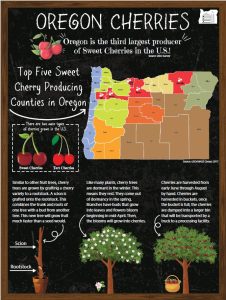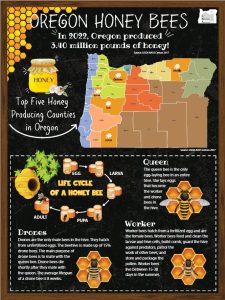This 2-sided 18×24″ poster features Oregon’s cherry industry and the life cycle of Honey bees. A great additional to celebrate the upcoming Spring season.


Students read How to Grow a Monster, describe the needs of a zucchini plant, identify the structure and function of zucchini plant parts, grow classroom zucchini plants, and experiment with different environments and growing conditions. Kit includes a copy of the book, How to Grow a Monster, cups and seeds for a class set of 25 students. This kit does not need to be returned. Limit 1 per class.
Students explore tart cherry production in the United States and explain why producers and consumers are needed in the cherry industry. Kit includes 15 sets of the Cherry Trees to Cherry Treats cards. This kit does not need to be returned.
This beautiful 8.5 x 11 inch full color map of Washington County features unique commodities grown in the county. It is an excellent tool to bring a piece of the story one County plays in Oregon’s agricultural diversity to the classroom.
The Grown in Washington County Map helps students visualize where things are grown right in their backyard. On the back of the map student’s can learn some more information about the unique commodities grown in the County and how they support the diversity of Oregon agriculture.
Maps are free to Oregon teachers. If you would like a classroom set please let us know how many to send!
Lynne Boddy
Did you know that fungi are made to make medicine for humans? Or that the most mushrooms can be seen in autumn? This picture book about nature is packed with fun facts about fungi. It includes gross-out stories of fungal infections that kids will love, incredible facts about “bananageddon”, crop disease, epidemics, and zombified ants! It’s the ultimate gift for children who are interested in nature and microorganisms. Book must be returned.
Catherine O'Neil Grace, Margaret M. Bruchac, Plimoth Plantation
Countering the prevailing, traditional story of the first Thanksgiving, with its black-hatted, silver-buckled Pilgrims; blanket-clad, be-feathered Indians, this lushly illustrated photo-essay presents a more measured, balanced, and historically accurate version of the three-day harvest celebration in 1621. Pair this with resources teaching about harvest traditions specific to Oregon tribes!
A Classroom set is is 15 copies of the book. Must Be returned.
Kim Binczewski & Bethany Econopouly
It’s a sleepy Saturday morning for most people, but not for Iris, who has to feed her many pets before Aunt Mary arrives. Iris likes to call Aunt Mary “Plant Mary” because she is a plant scientist.
Today Aunt Mary wants to experiment with making whole wheat sourdough bread from scratch! As the family kitchen transforms into a bread lab, Iris is surprised that bread needs only four ingredients―flour, water, salt and starter. She also learns about the invisible microbes that make the dough rise, and how flour comes from wheat grown by farmers. It all seems magical, but it’s really science. This book needs to be returned.
Jodi Icenoggle
Gillian Doherty
Invites young readers to find various quantities of such things as farm animals and tools which are labeled in the illustrations of rural scenes, including a sheep farm, an orchard, a rice paddy, and bee hives. This book needs to be returned.
Discover how technological advances and economic forces influence the size of farms in the United States. Evaluate the pros and cons of large-scale agriculture for the production of our food, fuel and fiber and identify the similarities and differences in commercial vs subsistence farming. The kit will include six sets of 21 Farm Profile cards. This kit includes materials for six groups of students. This kit does not need to be returned.